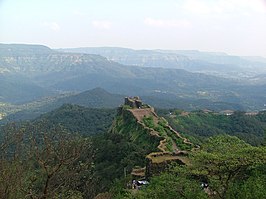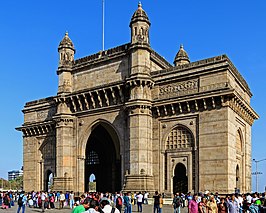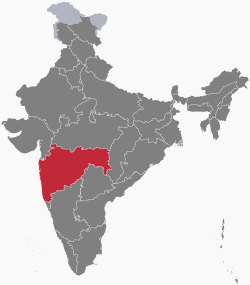Maharashtra state
| Population growth | |||
|---|---|---|---|
| Census | Pop. | %± | |
| 1961 | 39,554,000 |
—
|
|
| 1971 | 50,412,000 | 27.5% | |
| 1981 | 62,784,000 | 24.5% | |
| 1991 | 78,937,000 | 25.7% | |
| 2001 | 96,752,000 | 22.6% | |
| 2011 | 112,373,000 | 16.1% | |
| Source:Census of India | |||
Maharashtra (/mɑːhəˈrɑːʃtrə/; Marathi: महाराष्ट्र pronunciation: locally: [məharaːʂʈrə], abbr. MH) is a state in the western region of India and is India's second-most populous state and third-largest state by area.
It is the wealthiest Indian state. It is also the world's second-most populous sub-national entity. It has over 112 million inhabitants and its capital, Mumbai, has a population of approximately 18 million. Nagpur is Maharashtra's second capital as well as its winter capital. Maharashtra's business opportunities along with its potential to offer a higher standard of living attract migrants from all over India.
Ancient and medieval Maharashtra included the empires of the Satavahana dynasty, Rashtrakuta dynasty, Western Chalukyas, Mughals and Marathas. Spread over 118,809 sq mi (307,710 km2), it is bordered by the Arabian Sea to the west and the Indian states of Karnataka, Telangana, Goa, Gujarat, Chhattisgarh, Madhya Pradesh and the Union territory of Dadra and Nagar Haveli. The major rivers of the state are Godavari, and Krishna. The Narmada and Tapti Rivers flow near the border between Maharashtra and Madhya Pradesh and Gujarat. Maharashtra is the second most urbanised state in India. The state has several popular Hindu places of pilgrimage including Pandharpur, Dehu and Alandi,shegaon. Other places that attract pilgrims from other parts of India and beyond include Hazur Sahib Gurudwara at Nanded, Sai Baba shrine at Shirdi and Dikshabhumi at Nagpur.
...
Wikipedia







